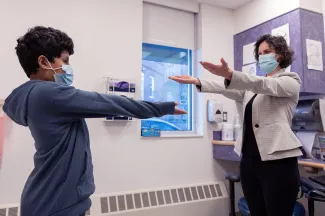Tics and Tourette Syndrome | Symptoms & Causes
What are the symptoms of Tourette syndrome?
Tic disorders and Tourette syndrome involve repetitive, involuntary movements or vocalizations called tics. These tics fall into two main categories: motor, leading to body movement, and vocal, resulting in a sound. Additionally, tics are categorized as either simple, affecting only a few body parts, or complex, involving multiple body parts.
Examples of simple and complex tics include:
Motor Tics
Simple
- Eye blinking/movements
- Nose movements
- Shoulder shrug
- Abdominal tensing
Complex
- Facial movements
- Head gestures
- Shoulder movement
- Bending or gyrating
- Echopraxia (mimicking other’s actions)
Vocal Tics
Simple
- Throat clearing
- Coughing
- Sniffing
- Grunting
Complex
- Echolalia (repeating other’s words)
- Palilalia (repeating one’s own words or phrases)
- Coprolalia (obscene words)
- Disinhibited speech
Tics usually begin between the ages of 5 and 10 with mild, simple tics involving the face, head, or arms. Over time, tics become more frequent and increase in variety, involving more body parts such as the trunk or legs, and often become disruptive to daily life.
What causes tics and Tourette syndrome?
The causes of tic disorders and Tourette syndrome are not completely understood, but it has been found that Tourette syndrome often runs in families. Nearly 70-80 percent of patients with Tourette syndrome have a genetic predisposition, making it one of the most inheritable childhood-onset neuropsychiatric disorders. While there isn’t a single gene responsible for Tourette syndrome, mutations in various genes have been found in affected families. In addition, environmental factors such as infections, autoimmune conditions, hormonal imbalances, behavioral conditions, or events or factors during pregnancy and birth might also contribute to the development of these disorders.
What other conditions accompany tic disorders and Tourette syndrome?
Children and young adults diagnosed with Tourette syndrome frequently experience emotional, behavioral, or developmental challenges, including anxiety, obsessive-compulsive disorder (OCD), attention-deficit/hyperactivity disorder (ADHD), and learning disabilities. At Boston Children’s, we prioritize a multidisciplinary approach, bringing together various specialists to meet each child’s diverse needs and create a personalized treatment plan.
Tics and Tourette Syndrome | Diagnosis & Treatments

How are tics and Tourette syndrome diagnosed?
Clinicians such as pediatricians, child psychiatrists, child neurologists, or qualified mental health professionals clinically diagnose tic disorders. They will recommend a comprehensive evaluation of your child’s psychological, social, and educational status, along with a thorough medical, developmental, and family assessment. To understand your child’s behavior, these professionals gather detailed information from both caregivers and teachers, along with direct observation. Neuroimaging and lab testing are not required for diagnosis.
How are tic disorders and Tourette syndrome treated?
Specific treatment for tic disorders and Tourette syndrome may involve behavioral therapy and/or medications. Treatment will be determined by your child’s physician based on:
- Your child’s age, overall health, and medical history
- The extent of disruption caused by tic behavior
- Your child’s tolerance for specific medications, procedures, or therapies
- Expectations for the course of the syndrome
- Your opinion or preference
The impact of symptoms on a child’s self-concept, family, and peer relationships, and classroom participation guides their treatment needs. In many cases, Tourette syndrome isn’t disabling, and normal development occurs without requiring treatment. Children with Tourette syndrome usually function well at home and in standard classroom settings. If a child develops emotional or learning concerns, special classes, psychotherapy, or medication may be needed. When tics disrupt daily life or school performance, or if other disorders are present (e.g., obsessive-compulsive disorder, attention-deficit/hyperactivity disorder), effective medications are available.
How we care for tics and Tourette syndrome
Our Tic Disorders and Tourette Syndrome Program provides a multidisciplinary team of specialists who take a holistic approach to the needs of each child with a tic disorder. We work closely with community psychologists and therapists, helping patients determine the most suitable medications or behavioral therapies. These therapies may involve referrals for Cognitive Behavioral Therapy (CBT), Habit Reversal Therapy (HRT), Exposure Response Prevention Therapy (ERP), and Comprehensive Behavioral Intervention for Tics (CBIT). Kinga Tomczak, MD, PhD, a child neurologist and director of the Tic Disorders and Tourette Syndrome Program, is one of the few certified child neurologists in the U.S. for CBIT.



